10 Benefits of Using External Data for Market Research

10 Benefits of Using External Data for Market Research
Overview
Utilizing external data for market research presents several compelling features, including:
- Enhanced decision-making capabilities
- Cost-effectiveness
- The potential to uncover competitive advantages
These datasets allow organizations to improve their market analysis by providing insights that might be overlooked when relying solely on internal data. As a result, companies can reduce research costs and identify new opportunities, ultimately leading to better strategic positioning. This can foster innovation in a dynamic marketplace, enabling businesses to adapt and thrive.
How might your organization benefit from integrating external data into its research practices?
Introduction
The landscape of market research is evolving rapidly, marked by a significant shift towards integrating external data sources. This trend underscores a growing recognition of the diverse insights such data can offer, empowering organizations to make informed decisions and maintain a competitive edge. As businesses increasingly harness external datasets, a critical question emerges: how can they effectively utilize these resources to enhance their market analysis and drive innovation? This article delves into ten compelling benefits of utilizing external data, illustrating how it can transform research strategies and promote a more agile approach to understanding market dynamics.
Initial Data Offering: Access to Diverse External Datasets
The Initial Data Offering (IDO) serves as a vital centralized platform, granting users access to a diverse array of external data datasets, including alternative data, fundamentals data, and ESG data. This extensive selection enables companies to explore various facets of research, ensuring they have the essential information required for informed decision-making. In 2025, a significant percentage of businesses are expected to utilize external data for market research, reflecting a growing trend towards data-driven strategies.
What advantages do these datasets provide? Successful instances are plentiful, with companies utilizing alternative information to gain competitive advantages, such as improving customer insights and optimizing operational efficiencies. By leveraging IDO's distinct datasets, organizations can greatly enhance their research capabilities, advancing beyond conventional sources to uncover valuable insights that foster innovation and strategic planning.
The significance of centralized platforms like IDO cannot be overstated. They enhance information access and integration, ultimately promoting a more knowledgeable and flexible approach to research. As businesses increasingly turn to external data, the role of IDO in facilitating this transition becomes even more crucial.
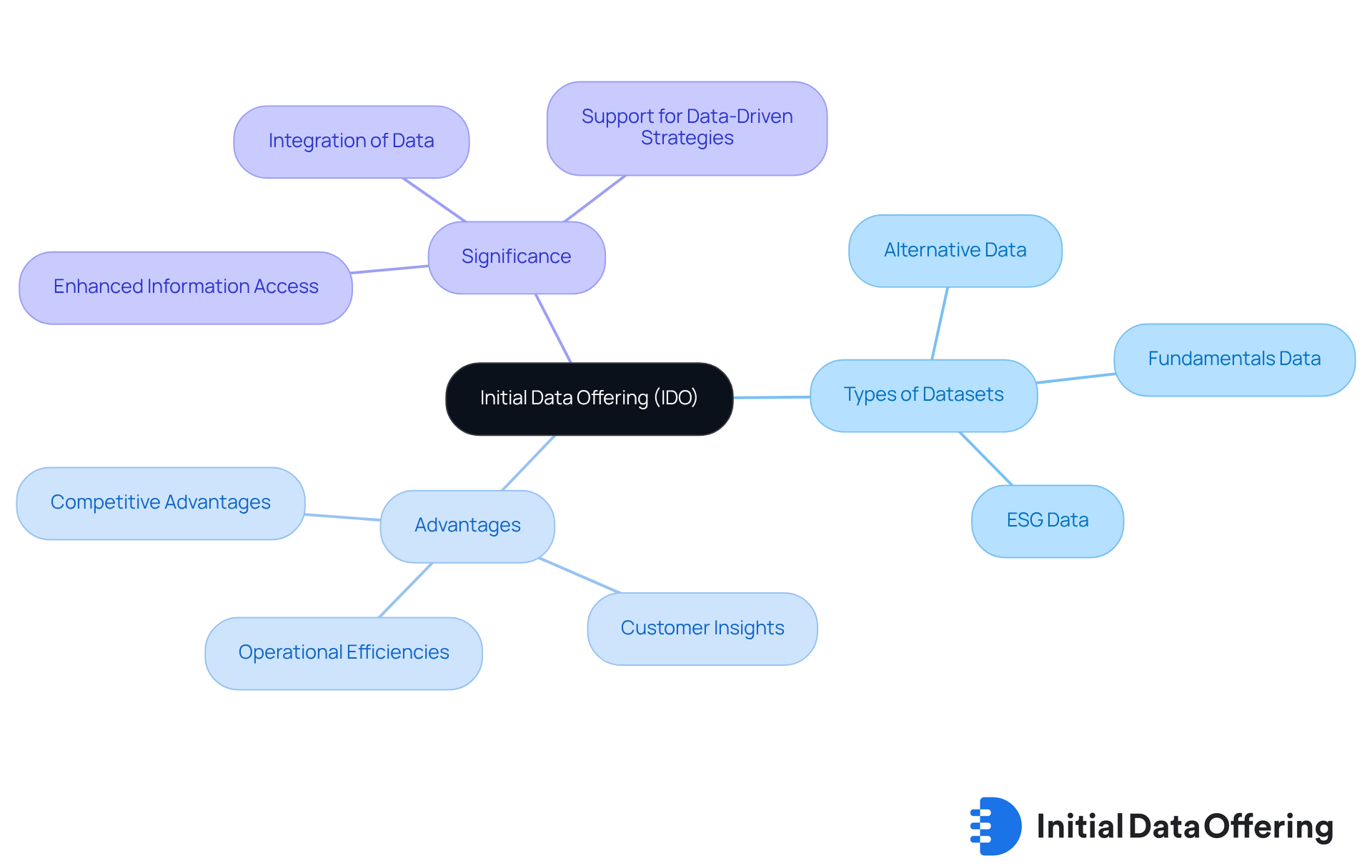
Improved Decision-Making: Leveraging External Data Insights
Utilizing external data provides companies with significant insights into trends and consumer behavior. This integration allows organizations to make informed decisions that align with evolving market demands.
For example, how can examining consumer sentiment data refine marketing strategies? By doing so, companies can ensure they connect more effectively with their target audience. This strategic alignment not only enhances customer engagement but also drives improved business outcomes.
In fact, companies leveraging consumer sentiment insights have reported notable increases in campaign effectiveness and customer satisfaction. As the landscape of consumer behavior evolves, the ability to adapt through external data becomes essential for maintaining a competitive advantage.
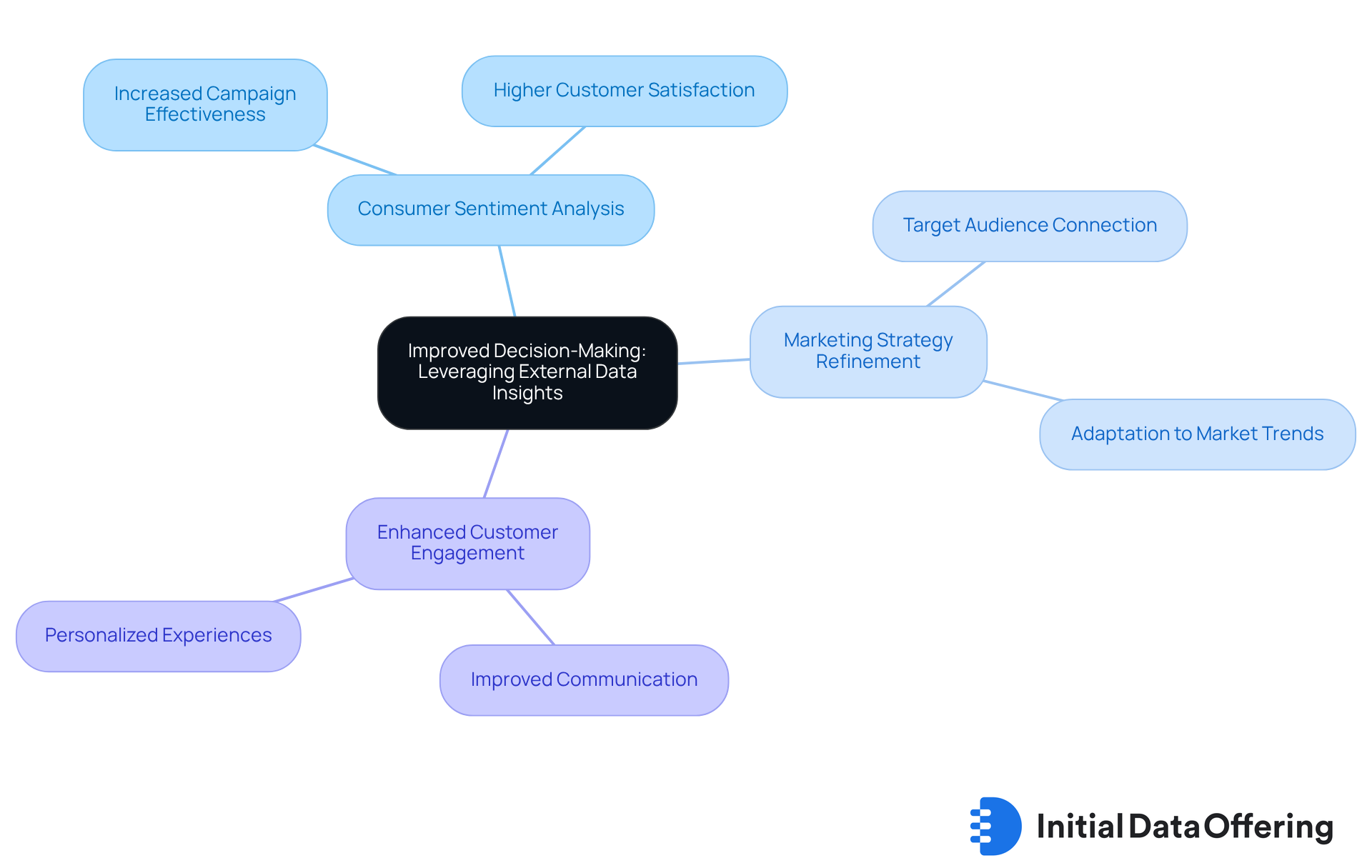
Competitive Advantage: Gaining Insights from External Data
Utilizing external data enables companies to discover insights that might escape their rivals. This exposure to new market trends, consumer preferences, and competitor tactics provides a strategic advantage, allowing organizations to position themselves effectively in the marketplace. By tailoring their offerings to meet the evolving demands of consumers, companies can secure a competitive edge. For instance, a company that identifies a rising trend in sustainability can adapt its product line to align with consumer expectations. This adaptability not only responds to current market conditions but also anticipates future demands.
A recent study by David Schatsky reveals that almost half of businesses are utilizing external data in their analytics efforts, underscoring its increasing significance. Furthermore, 92% of analytics experts believe their organizations must enhance the use of external data. Schatsky emphasizes that examining external data can assist companies in identifying risks and opportunities that they would overlook if their inputs were restricted to information produced from internal processes. This insight suggests that companies can not only react to market changes but also foresee them, fostering innovation and growth.
Experts assert that organizations at the forefront of information and analytics are more likely to leverage external data for insights. This enables them to recognize risks and opportunities that internal information alone might overlook. Thus, adopting a comprehensive approach to information use is crucial for navigating today's ever-changing commercial environment. How can your organization better utilize outside information to enhance decision-making and strategic positioning? By considering these insights, businesses can better equip themselves to thrive in a dynamic marketplace.
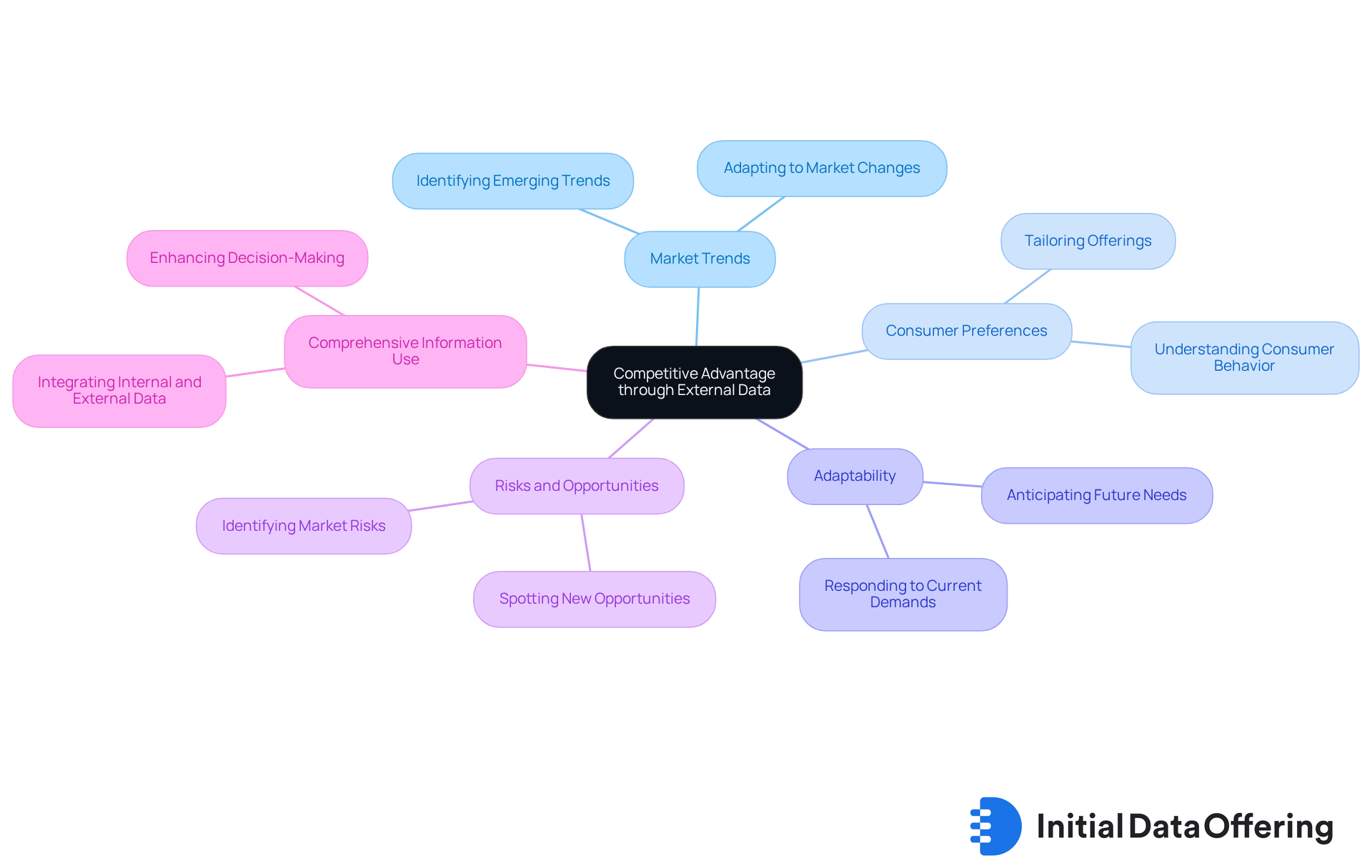
Enhanced Market Analysis: Enriching Insights with External Data
External information greatly enhances analysis by providing context and depth to current research. For instance, when companies merge internal sales information with outside market trends, they can discover market opportunities ready for exploitation. This integration not only enhances the understanding of customer behavior but also informs strategic decision-making. Statistics suggest that organizations utilizing both internal and external information can attain a $1.5 million boost in operational efficiency. Moreover, companies are missing out on about $5.2 million in income due to underutilized information resources, emphasizing the critical need for proficient analysts.
By employing external data, including Hazeltree's Long and Short Equity Positioning Insights, companies can significantly enhance their strategies in the financial realm. This proprietary dataset captures long and short positions across equities and swaps worldwide, sourced from over 600 funds representing $700 billion in GMV. It provides comprehensive insights into equity crowding and fund positions, leading to improved lead generation and customer satisfaction.
This comprehensive approach to information analysis enables organizations to navigate intricate market dynamics effectively, ensuring they stay competitive in a changing landscape. How can your organization leverage such datasets to enhance decision-making and capitalize on market opportunities? By understanding the features and advantages of these insights, businesses can unlock their full potential and drive growth.
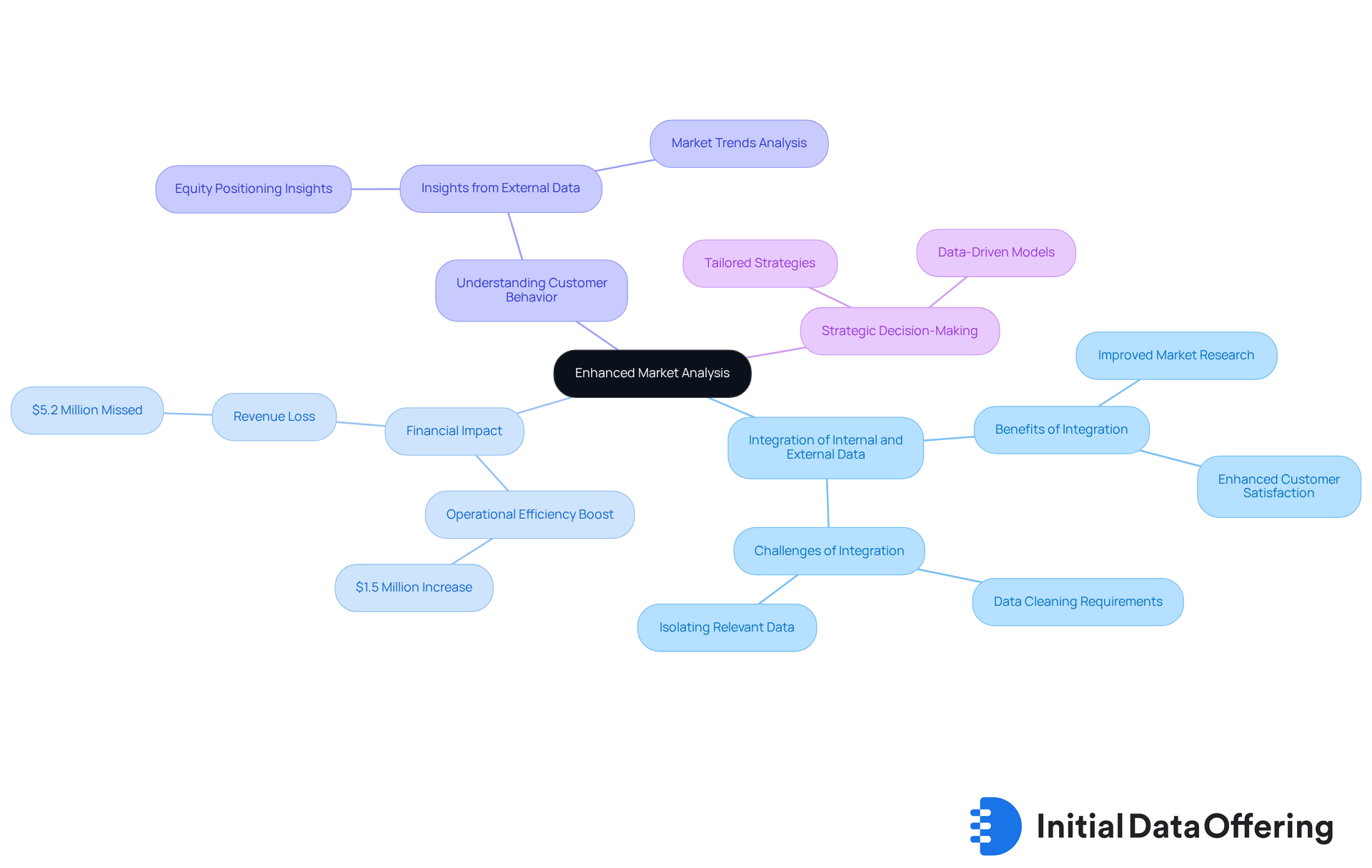
Cost-Effectiveness: Reducing Research Expenses with External Data
Utilizing external data presents a compelling feature for businesses aiming to reduce expenses linked to primary research. By leveraging external data, organizations can significantly cut costs associated with conventional research techniques, such as surveys and focus groups. This approach not only enhances cost-effectiveness but also allows firms to reallocate resources toward other critical operational areas while still obtaining valuable insights. For instance, companies that incorporate outside information have reported average decreases in research costs by as much as 30%. This enables them to optimize their research procedures and concentrate on strategic initiatives.
Moreover, specialists emphasize that the integration of external data not only reduces expenses but also enhances the quality of insights obtained. By offering a broader context for evaluation, these datasets, which include external data, provide a dual advantage of cost reductions and improved information quality. Dr. Jennifer Priestley aptly states, "Ultimately, to be a successful analyst or scientist in this field, it’s not enough to be purely technical, nor will it suffice to be a market enthusiast; you need to bridge the gap between the two." This insight underscores the importance of balancing technical expertise with market understanding.
A pertinent case study illustrating this concept is the LED lighting upgrade at ZINK Imaging, which resulted in a remarkable 79% decrease in yearly lighting energy consumption. This upgrade not only led to substantial operational cost savings but also demonstrated how external data can enhance both efficiency and effectiveness. As organizations seek to enhance their research initiatives, the incorporation of external data emerges as an essential asset, fostering both cost savings and improved decision-making.
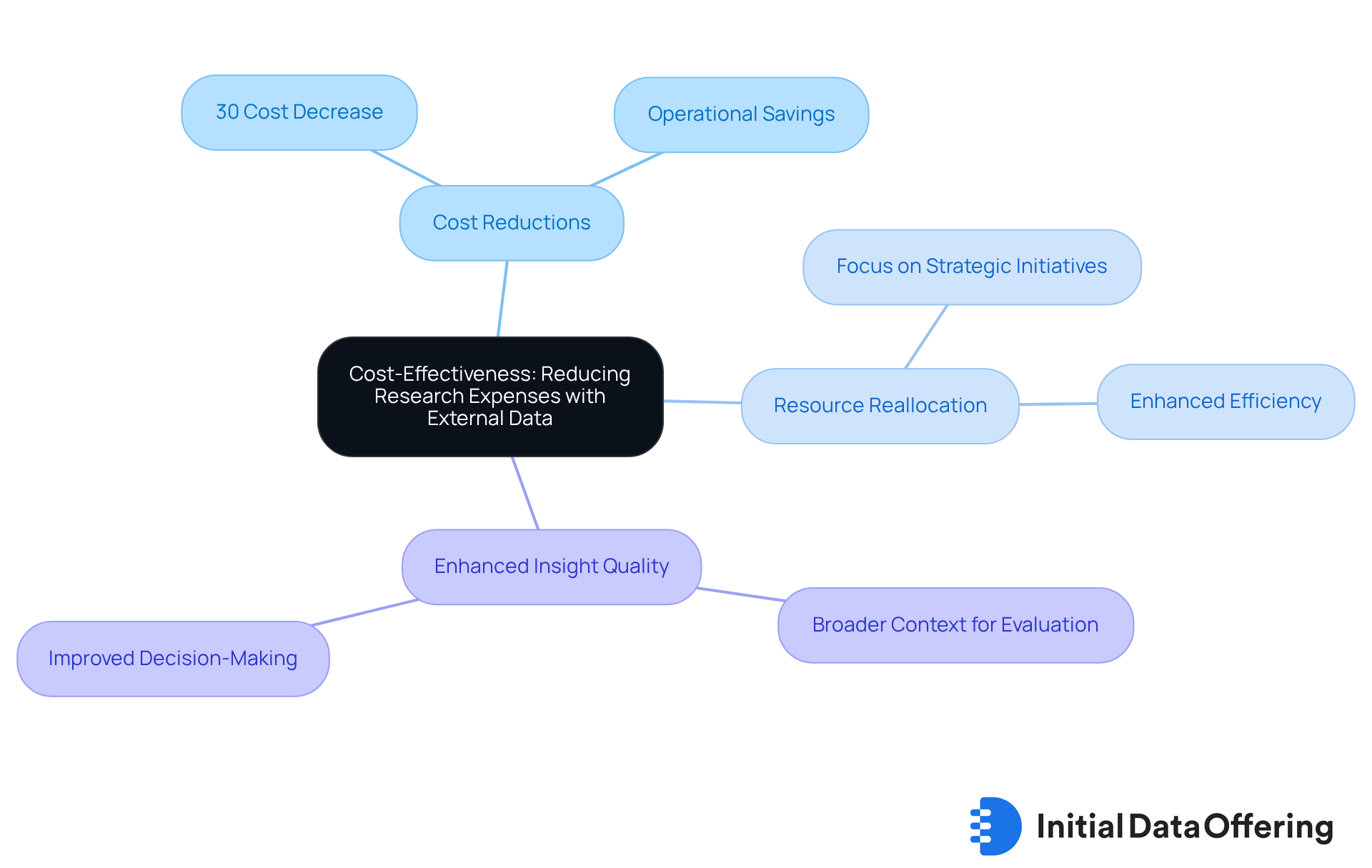
Opportunity Identification: Discovering New Markets with External Data
Recognizing new business opportunities often requires the integration of external data that may not be immediately apparent. By examining demographic information, consumer behavior patterns, economic signals, and external data, companies can uncover emerging sectors that align with their products. For instance, a company might identify a rising demand for eco-friendly products in a particular region. This insight prompts a strategic adjustment in their marketing efforts, allowing them to better cater to the evolving consumer preferences.
How might your organization leverage such data to enhance its market positioning?
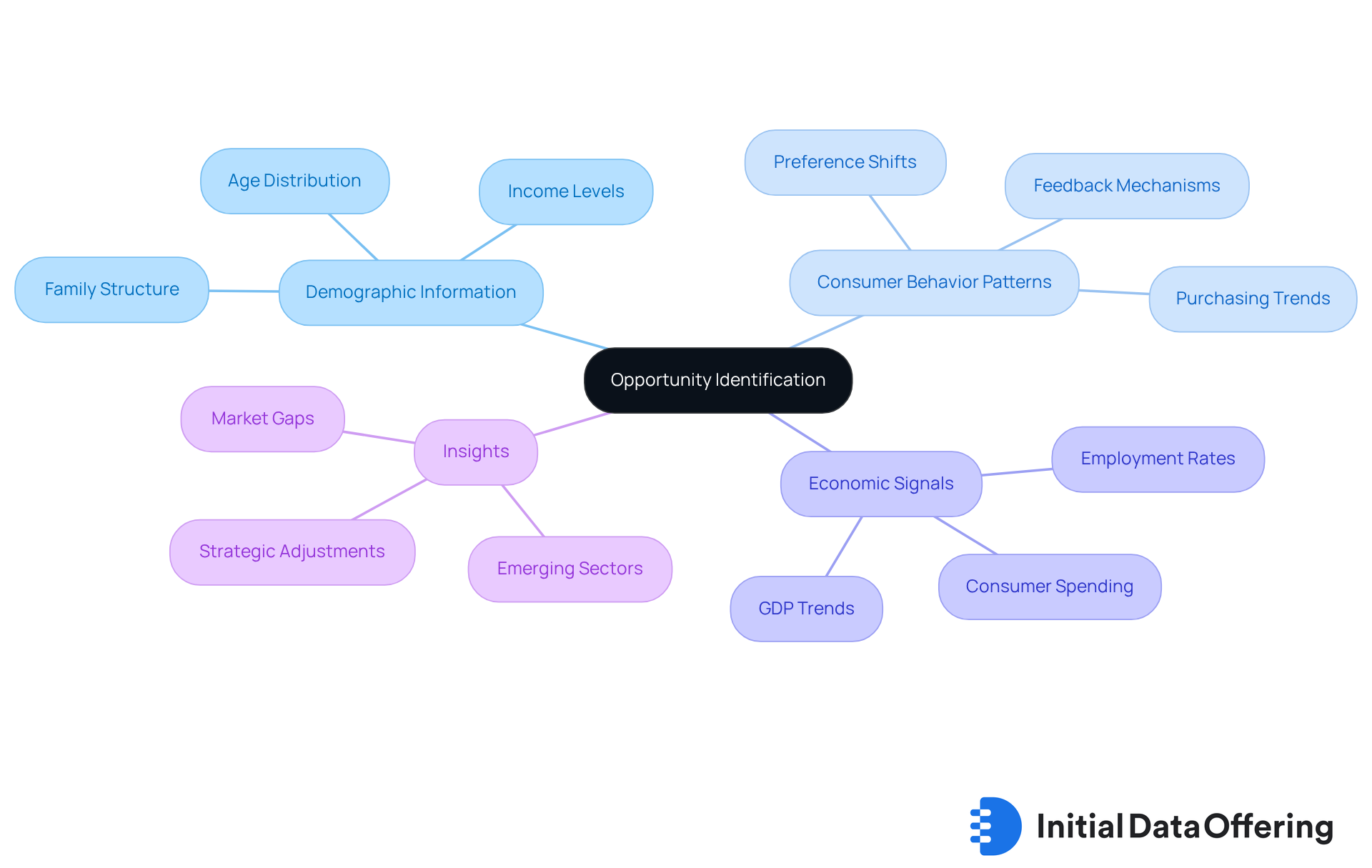
Data Accuracy: Enhancing Reliability with External Data
Integrating outside information into market research significantly enhances the precision of results. By cross-referencing internal data with trustworthy external data sources, businesses can confirm their insights, ensuring they are grounded in reliable information. This practice is essential; a 2019 survey indicated that 92% of analytics professionals believe companies should enhance their use of outside information to improve decision-making. The incorporation of external data enhances trust in strategic decisions and mitigates uncertainties associated with inadequate information quality.
For instance, organizations like Hartford Steam Boiler leverage extensive information available at no cost from data.gov, which provides over 200,000 collections from various government agencies, to enhance their predictive capabilities. Moreover, organizations that utilize external data report improved customer insights and enhanced predictive abilities, ultimately leading to financial benefits. This underscores the importance of information verification in industry analysis, as it allows companies to develop a more comprehensive understanding of trends and consumer behaviors, resulting in improved outcomes.
How can your organization benefit from integrating outside information? By adopting these practices, businesses can not only refine their decision-making processes but also gain a competitive edge in their respective markets.
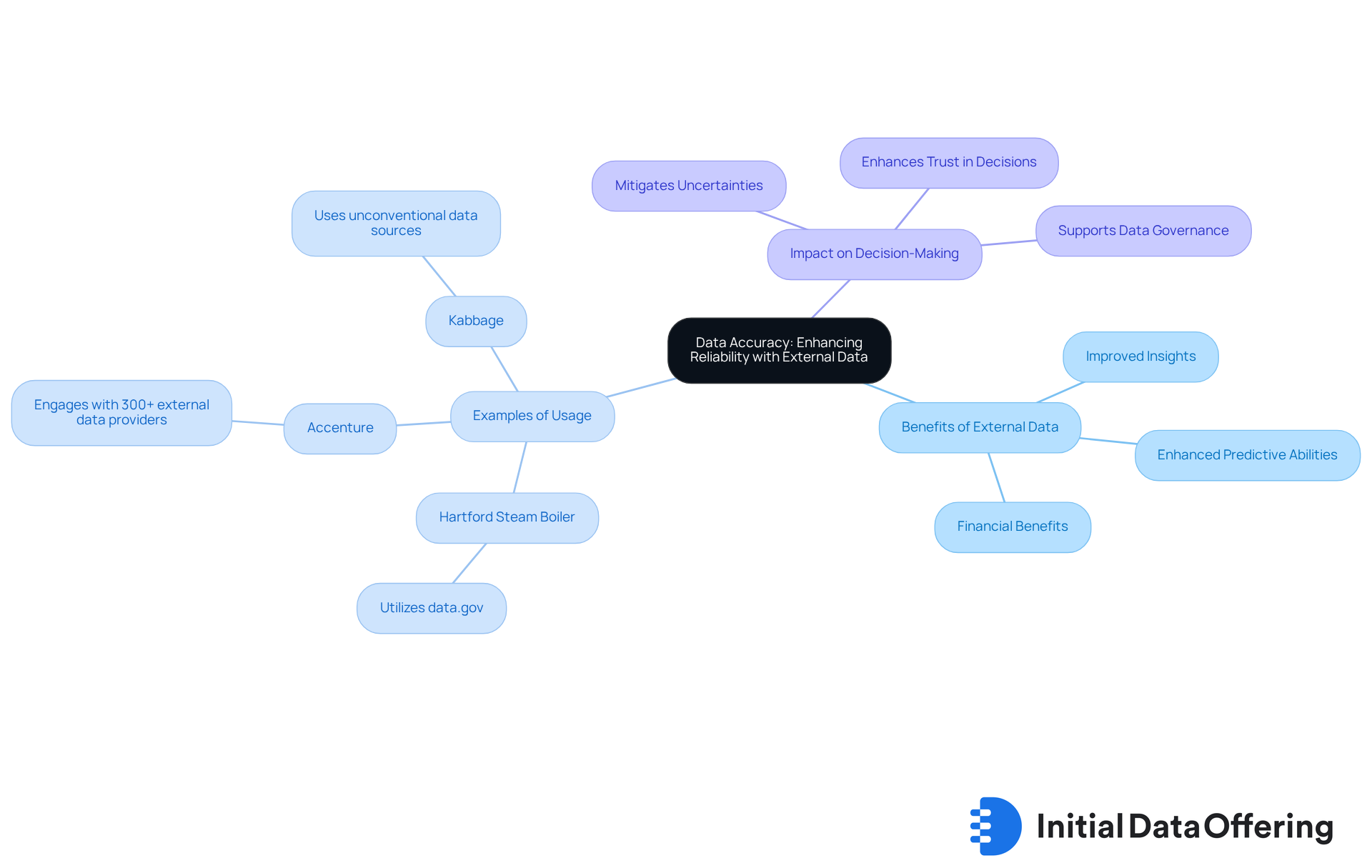
Real-Time Access: Staying Updated with External Data
Instant access to external data is a critical feature that enables companies to remain flexible amid changing industry trends and customer preferences. The advantage of this urgency is that organizations can swiftly modify their marketing tactics or launch new products in response to industry dynamics.
For instance, companies leveraging external data like real-time social media analytics can gain valuable insights into evolving consumer sentiments. This capability allows them to refine their messaging and enhance engagement effectively.
Studies indicate that approximately 70% of firms utilize real-time information to shape their marketing strategies, underscoring the essential role of prompt insights in fostering success. Furthermore, expert insights suggest that organizations that efficiently harness real-time information not only improve their responsiveness but also enhance their overall strategic planning. This leads to better alignment with consumer needs and market demands, ultimately benefiting their long-term growth and adaptability.
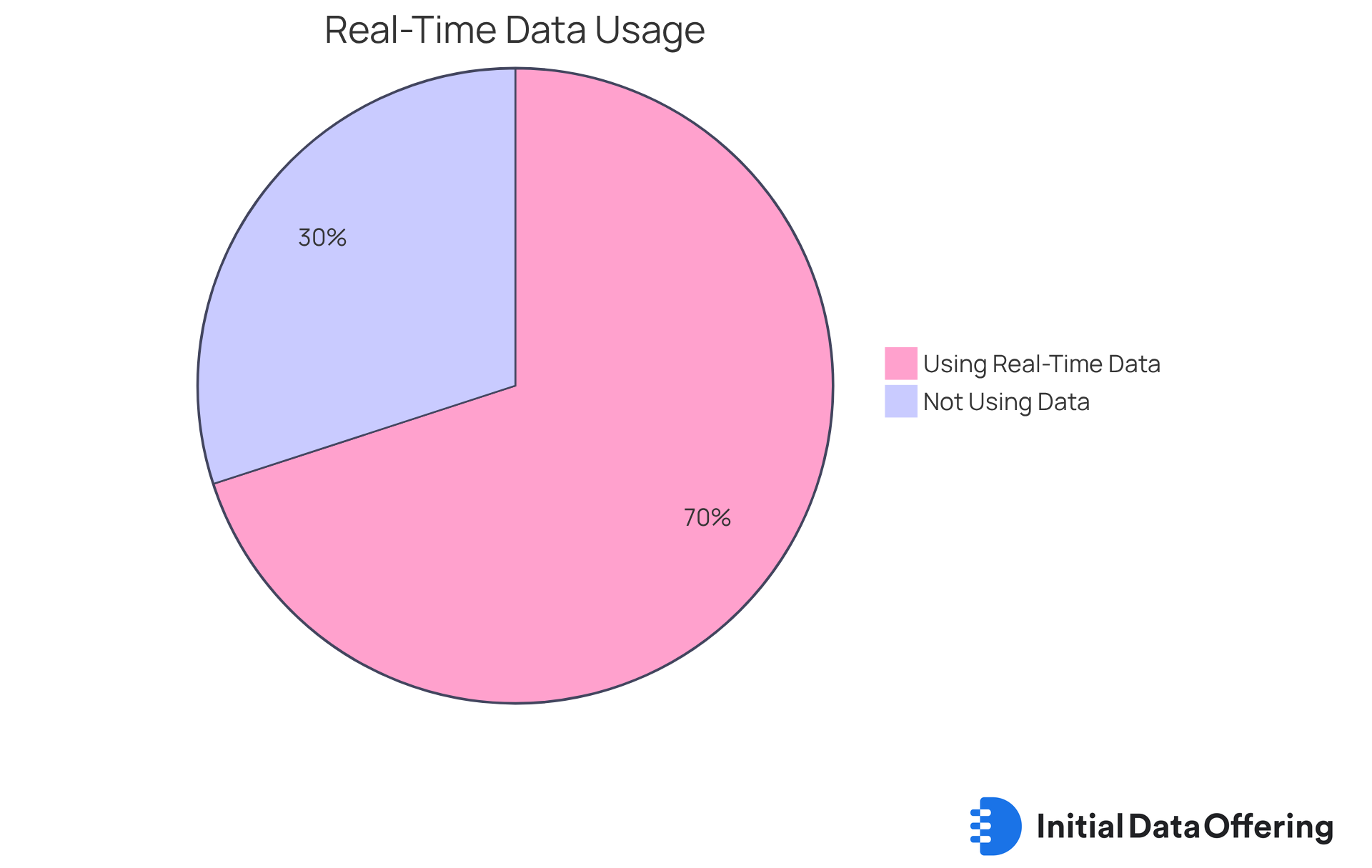
Collaboration Opportunities: Sharing Insights through External Data
External information serves as a catalyst for collaboration among organizations, establishing a shared foundation for insights that can effectively address industry challenges. By sharing information and findings, companies can combine their efforts to innovate and develop solutions.
For instance, firms within the same industry often collaborate on research projects, merging their external information resources to gain deeper insights into market dynamics. This collaborative approach not only enhances the quality of insights but also cultivates a culture of shared knowledge, essential for driving advancements in the industry.
Notably, a significant proportion of organizations are now engaging in collaborative research efforts that leverage external data, underscoring the growing recognition of the value of information sharing. Such partnerships can lead to groundbreaking discoveries and improved strategies, ultimately benefiting all stakeholders involved.
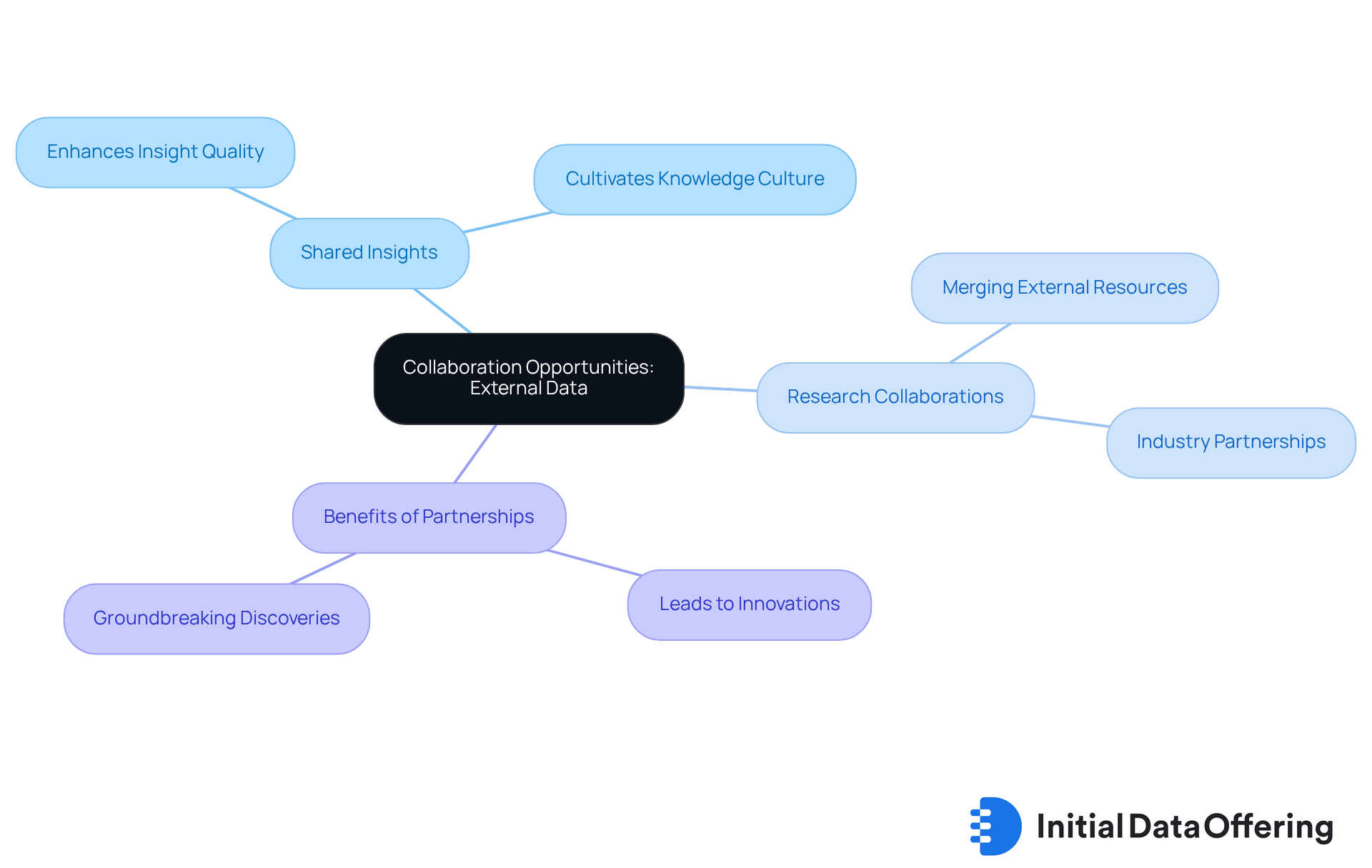
Innovation Driver: Fueling New Strategies with External Data
Outside information serves as a strong catalyst for innovation, providing fresh viewpoints that motivate new strategies. By analyzing trends and consumer feedback from various outside sources, organizations can identify market gaps and create innovative solutions to meet unfulfilled needs. For instance, over 70% of healthcare institutions now utilize cloud-based analytics, enabling them to leverage predictive models that enhance patient outcomes and reduce costs. This approach not only improves service delivery but also reveals opportunities for new product features that can keep companies ahead of their competitors.
Additionally, companies implementing information-driven strategies have reported a remarkable 63% increase in productivity, highlighting the concrete advantages of incorporating outside insights into their operational frameworks. Significantly, 87% of executives believe innovation is crucial for their organization's success and growth, underscoring the vital role of outside information in promoting innovation. As the worldwide analytics sector is anticipated to surpass $132.9 billion by 2026, the need for practical, real-time information will continue to transform industry benchmarks, compelling organizations to innovate and adapt in a continually changing environment.
Moreover, firms such as JPMorgan Chase have enhanced their credit risk evaluation abilities through large-scale information analysis, illustrating how outside information can lead to substantial operational advancements. Thus, the integration of external data is essential for organizations aiming to thrive in competitive markets. How might your organization leverage outside information to foster innovation and improve operational efficiency?
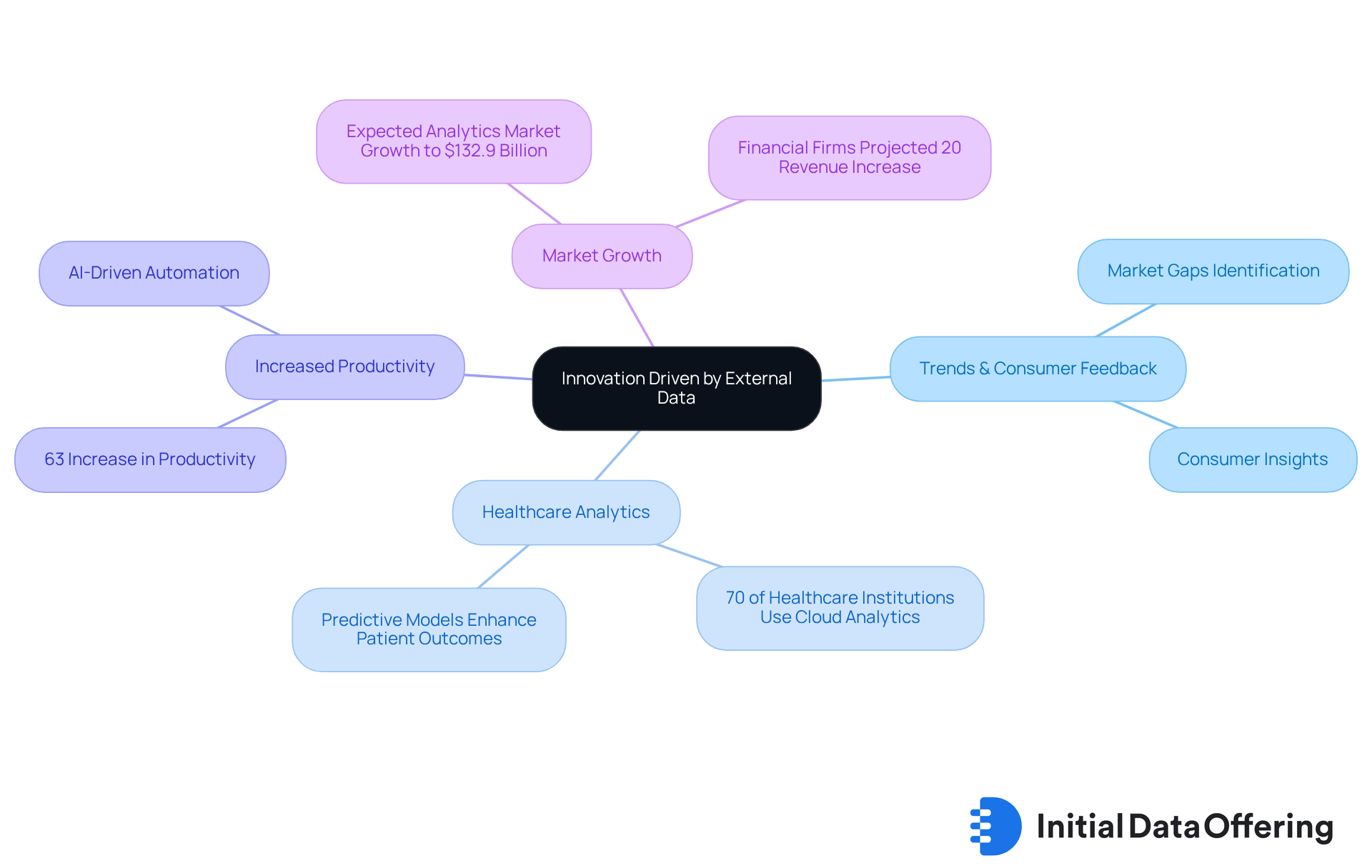
Conclusion
Utilizing external data for market research presents a transformative opportunity for businesses aiming to enhance their strategic decision-making and competitive positioning. By embracing diverse datasets, organizations can unlock valuable insights that inform their strategies and foster innovation and adaptability in a rapidly changing market landscape.
The numerous advantages of integrating external data are clear:
- Improved decision-making
- Enhanced market analysis
- Cost-effectiveness
- Real-time access to insights
Companies leveraging this wealth of information can identify new opportunities, maintain accuracy in their research, and collaborate effectively to drive industry advancements. As reliance on external data continues to grow, organizations must evolve their strategies to include these critical resources.
In conclusion, the integration of external data is not just a trend; it is a necessity for businesses seeking to thrive in today's competitive environment. The potential for innovation, cost savings, and enhanced decision-making underscores the importance of adopting a comprehensive approach to data utilization. Organizations are encouraged to explore and leverage external data sources to stay ahead of market demands and foster a culture of continuous improvement and growth.
Frequently Asked Questions
What is the Initial Data Offering (IDO)?
The Initial Data Offering (IDO) is a centralized platform that provides users access to a diverse range of external datasets, including alternative data, fundamentals data, and ESG data, facilitating informed decision-making for businesses.
How does the IDO benefit companies?
The IDO allows companies to explore various facets of research, enhancing their research capabilities beyond conventional sources and uncovering valuable insights that foster innovation and strategic planning.
Why is external data important for businesses?
External data offers significant insights into trends and consumer behavior, enabling companies to make informed decisions that align with market demands, ultimately improving customer engagement and business outcomes.
How can consumer sentiment data improve marketing strategies?
By examining consumer sentiment data, companies can refine their marketing strategies to connect more effectively with their target audience, leading to increased campaign effectiveness and customer satisfaction.
What competitive advantages do companies gain from utilizing external data?
Companies can discover insights into new market trends, consumer preferences, and competitor tactics, allowing them to tailor their offerings and secure a competitive edge in the marketplace.
What does recent research indicate about the use of external data in businesses?
A study by David Schatsky shows that almost half of businesses utilize external data in their analytics efforts, highlighting its growing significance. Additionally, 92% of analytics experts believe organizations need to enhance their use of external data.
How can external data help companies identify risks and opportunities?
External data allows companies to recognize risks and opportunities that might be overlooked if relying solely on internal information, enabling them to react to and foresee market changes.
Why is a comprehensive approach to information use important for organizations?
A comprehensive approach to information use helps organizations navigate the dynamic commercial environment by leveraging both internal and external data for insights, fostering innovation and growth.